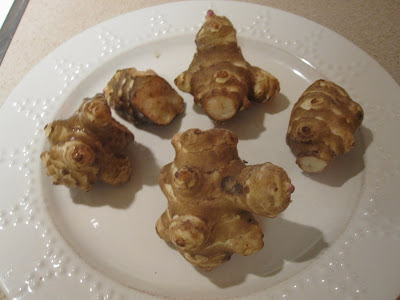The Jerusalem artichoke is a root tuber from a species of sunflower native to eastern North America.
They were cultivated by Native Americans before the arrival of the colonizing Europeans. For example, Samuel de Champlain, a French explorer, found domesticated plants at Cape Cod in 1605. The tubers are elongated and uneven, usually knobby, and look somewhat like ginger root.
The skin color can vary from pale brown, red and purple to white. Although those I bought were primarily pale brown, they had hints of purple and red. The inside flesh is white with a crisp texture,
much like jicama. They are one of the 1001 Foods You Must Taste Before You Die. Raw, they are a tad bit sweet, with a nutty flavor.
Cooked, the flavor is intensified and it gets a taste similar to an artichoke, where that part of the name comes from. As indicated, they are not native to Jerusalem and they are not artichokes, so more and more they are being referred to as sunchokes,
which is what the packaging read on those Judy bought for me.
I attempted to peel some and eventually decided it wasn't worth it. The knobs make the peeling difficult. I put on a little olive oil and salt and baked them in the oven along with some rutabaga and turnip.
Baking removes the crispiness. The Wikipedia article notes that it was named "best soup vegetable" at a festival in Nice in 2002. 1001 notes they are good braised and served with butter and cream. It also suggests they be roasted, or put in soups.







I really really like these. Fry em up with butter. I used to get them from the kosher Persian market in Santa Monica when I was living around there. I love the nutty flavor and root texture. I couldn't eat them that often because they bring AWFUL gas. Most things this good have consequences...
ReplyDeleteThey are very good in soup. They hold their texture much better than other root vegetables like turnips or kohlrabi. They're also pretty good raw. I didn't notice the gas (garlic is notorious for making me uncomfortable the next day).
ReplyDelete